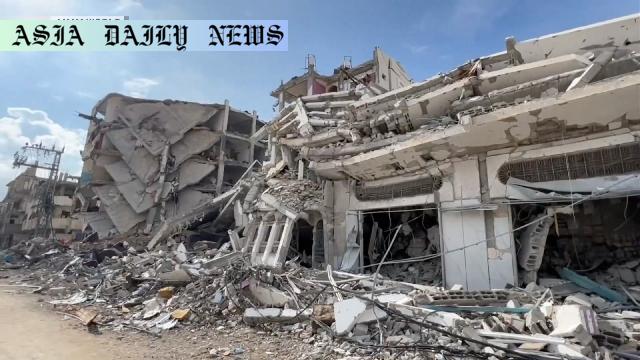Reconstruction: The recovery of Gaza will require at least $53.1 billion, according to the United Nations’ latest interim assessment.
Reconstruction of Gaza will cost at least $53.1 billion.
Over 60% of homes and 65% of roads have been destroyed.
Short-term recovery needs total $20.6 billion.
Removal of 50 million tons of debris presents challenges.
UN emphasizes Palestinian Authority’s role in rebuilding efforts.

Introduction: The Devastation in Gaza
The Gaza Strip, following prolonged conflict, finds itself in dire need of recovery and reconstruction. The United Nations has released an interim report, estimating that rebuilding the region could cost a staggering $53.1 billion. Spanning short, medium, and long-term efforts, these financial requirements are indicative of the catastrophic damage resulting from Israeli attacks. A six-week ceasefire agreement between Israel and Hamas has temporarily halted violence, allowing for critical evaluations to take place.
Scope of Destruction
The level of destruction in Gaza is unprecedented. According to the UN, more than 60% of homes and 65% of roads have been completely destroyed. Public infrastructure has not been spared either; an overwhelming 88% of schools have been damaged or destroyed, leaving children and youth with limited access to education. Beyond the physical toll, the emotional and economic impacts on Gaza’s population are immeasurable.
Challenges with Debris Removal
The recovery process faces significant challenges, including the removal of over 50 million tons of debris. This colossal amount is further complicated by contamination with hazardous materials and unexploded ordnance. Safe and efficient clearance will be essential, but the high costs and risks associated with this task contribute to the overall reconstruction expense.
Immediate and Long-Term Funding Needs
The UN breaks down Gaza’s recovery priorities into short, medium, and long-term categories. For the initial three years, approximately $20.6 billion will be required to stabilize and begin rebuilding essential sectors like housing, healthcare, and education. The remaining costs will stretch over a longer timeframe to ensure sustainable redevelopment and societal recovery.
UN’s Vision for Peace
The United Nations emphasizes that any reconstruction effort must occur within a framework of peace and justice. Secretary-General Antonio Guterres has reiterated the need for a two-state solution, with Israel and Palestine coexisting side by side. Central to this vision is the pivotal role of the Palestinian Authority, which the UN advocates should lead all planning and implementation of Gaza’s recovery operations.
US Interest in Gaza’s Future
US President Donald Trump has expressed an unusual level of interest, suggesting that the United States may “own” the Gaza Strip in the long run as they contribute to its reconstruction. This stance has sparked debate around international involvement in the region’s rebuilding efforts and the broader implications of foreign policy in a conflict-ridden zone.
Importance of Global Collaboration
To address the monumental task of rebuilding Gaza, international cooperation will be crucial. Nations across the globe must unite to provide both the financial support and political backing needed to ensure a sustainable recovery. The current situation represents an opportunity for the global community to step forward and demonstrate its commitment to peace and humanitarian aid.
Looking Ahead
The $53.1 billion reconstruction plan for Gaza is an ambitious yet necessary undertaking to restore hope and stability to the region. As efforts move forward, centering the voices and needs of Palestinians will be paramount in shaping a brighter future. Ultimately, the success of this recovery initiative hinges on international unity and sustained support for a just and peaceful resolution to the conflict.



Commentary
The Scale of Gaza’s Reconstruction
The Gaza Strip’s reconstruction represents a herculean task—one that underscores the immense human and financial cost of conflict. The estimated $53.1 billion is not merely a number; it’s a reflection of destroyed lives, homes, infrastructure, and futures. This figure brings into sharp focus the devastating impact of sustained violence and the compounded challenges of rebuilding amidst adversity. The fact that so many homes, roads, and even schools have been decimated highlights the direct targeting of essential services and the long road ahead for recovery.
Challenges and Key Stakeholders
One of the most profound challenges lies in addressing the sheer volume of debris—50 million tons—and the dangers it carries. Removing this safely requires not only resources but international expertise and collaboration. The UN’s calls to prioritize the Palestinian Authority’s role in reconstruction are significant. For true recovery to be meaningful, it must empower local governance structures rather than sideline them. However, foreign involvement—particularly the US claims of interest in Gaza’s future—adds a layer of complexity that could reshape the political dynamics of the region.
Hope Amidst Devastation
While the numbers and the destruction paint a bleak picture, the ongoing ceasefire offers a flicker of hope. The global community now has an opportunity to engage meaningfully, not just in providing monetary aid but by fostering a framework for sustainable peace. Rebuilding Gaza is as much about restoring its physical structures as it is about repairing its social fabric. A collaborative effort that centers peace, justice, and equity could pave the way for a brighter, more stable future for the people of Gaza and the broader region.